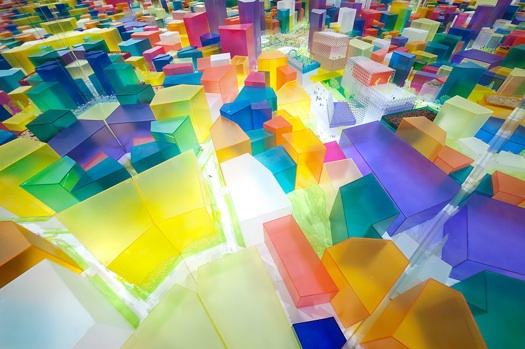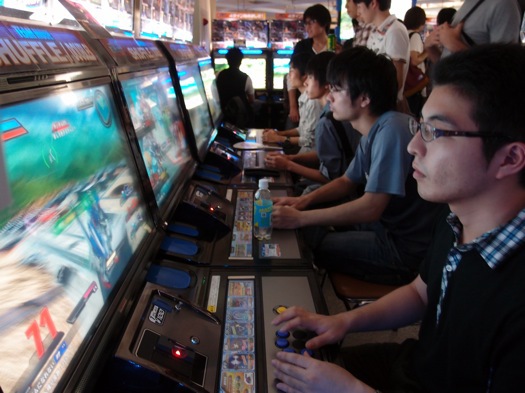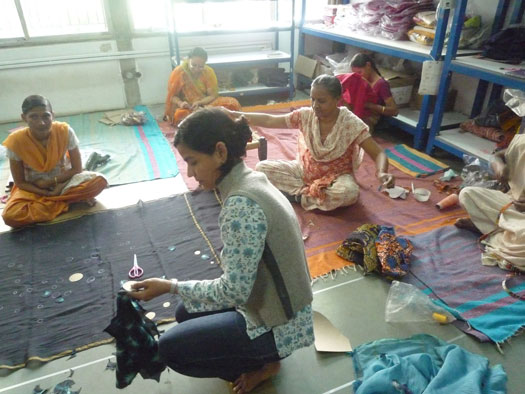
February 17, 2010
Better Living Through Artistry

DOSA designer Mona Shah with women artisans at the SEWA Trade Facilitation Centre in Ahmedebad, India. Photos: Jessica Helfand
In a refurbished textile mill in the Indian city of Ahmedebad, four women in sarees sit barefoot and cross-legged on the floor. One embroiders in a hoop, while another stitches silently at her side. Across the dimly lit room two more women kneel above a slice of fabric, gently placing circles of other fabric upon it: gradually, a constellation appears, and in her lightly accented — and perfect — English, the only woman in blue jeans explains to me what she is doing. “This is Orion,” she gestures, showing the emergence of a sequence that begins to resemble a familiar configuration in the night sky. She points to a stack of astronomy books perched nearby. “I’m trying to recreate the stars with the fabric,” she tells me, “the remnants, that is.”
She is Mona Shah — a textile designer working with Christina Kim of the Los Angeles–based Dosa — and her commitment to working with recycled material is not only a Dosa conceit but, I soon learn, an Indian one as well. I met Mona a few weeks ago when we toured the SEWA Trade Facilitation Centre, and where I saw, first-hand, the degree to which design functions in new and profound ways. It is to date the purest, most electrifying expression of design and social change I have yet to experience: the possibilities are not only endless but intoxicatingly gratifying on levels I didn’t think were even possible.
Founded in 1972 by Ela Bhatt, SEWA (Self Employed Women’s Association) is a trade union that represents 1.3 million women organized into more than 11,000 producer groups, 200 cooperatives and 11 federations in seven states across India, with the greatest concentration of members in the western state of Gujarat. (Sewa is also a Hindi word meaning “humble service.”) In recent years, SEWA has expanded its organization to provide services such as savings and credit, health care, child care, insurance, legal aid and job training. In 2003, the association created a number of independent nonprofit entities capable of supporting 15,000 skilled artisan women from Gujarat. One such enterprise operates three retail stores under the Hansiba brand, so named for an elderly woman, Hansibaben, the first rural artisan of SEWA. She is now in her early nineties.
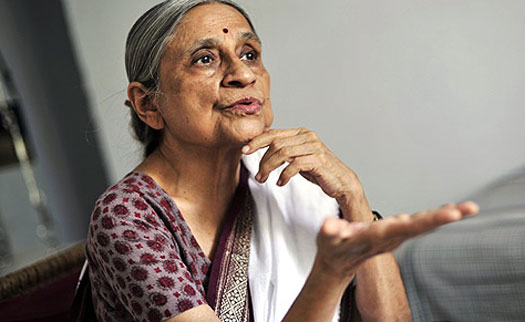
Ela Bhatt, founder of SEWA

Entrance to the Hansiba Shop, Mumbai
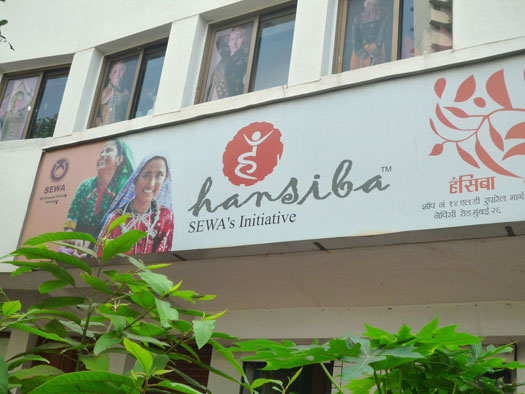
Facade of the Hansiba Shop, Mumbai
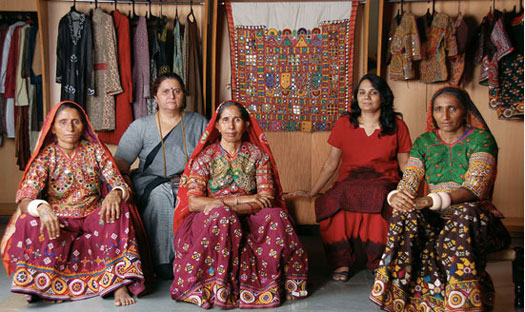
Villoo Mirza and Mona Dave of the SEWA Trade Facilitation Center with Gauriben Brahman and other female artisans
SEWA’s Trade Facilitation Centre (or TFC) is a cooperative textile manufacturing company with more than 3500 artisan shareholders. Rather than a sweatshop of working women, the TFC is employee-owned and produces higher-end (read “design-oriented”) fashion; it has, in addition, begun to produce show samples for many leading designers in Europe and Japan. It also manufactures clothing, jewelry and textiles for the Hansiba brand, now available not only in India but also for international export.
While approximately 60 percent of SEWA’s members lack basic literacy skills, the organization provides sophisticated training on a skills-appropriate basis — so a woman working in, say, SEWA’s organic farm (a third nonprofit business cooperative launched in recent years) will acquire math skills as she inventories seedlings, while a seamstress at the TFC, working with patterns, will gain comparable skills related to measuring and pattern-making. It is an extraordinary thing to observe: women helping women, providing benefits and engaging one another under a cooperative umbrella of give and take, education and training, growth and opportunity. A member of SEWA’s leadership team used the metaphor of a banyan tree to describe this model: “Each member contributes to the strength of the tree’s roots,” she explained, “while the branches grow independently, sprouting their own blooms.”
And so it is at the SEWA Trade Facilitation Centre, where hundreds of women cut and sew, measure and mend, bind and stencil. There are neatly queued assembly lines of women, working intently at their sewing machines, braids pulled tightly back as they carry on in an atmosphere that combines quiet diligence with nimble dexterity. The room is silent, except for the rhythmic whirring of the overhead ceiling fans. There is almost no talking. No one wears shoes. Spend one day in the streets here in Ahmedabad with its maniacal motorists and daredevil rickshaws and you immediately recognize the oasis of quiet that the temple or mosque so brilliantly provides. Step into the TFC, and you realize you’ve entered a parallel kind of environment: it’s a design temple.
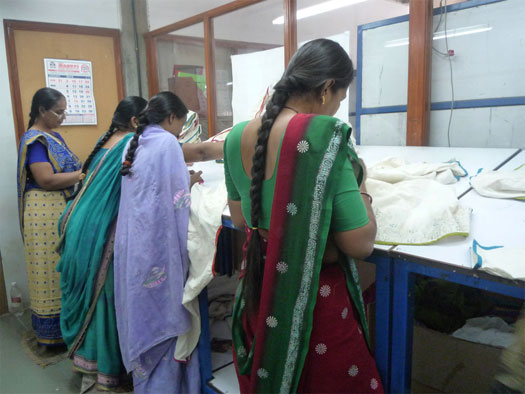
Women at SEWA Trade Facilitation Center, checking hem stiching on newly sewn garments
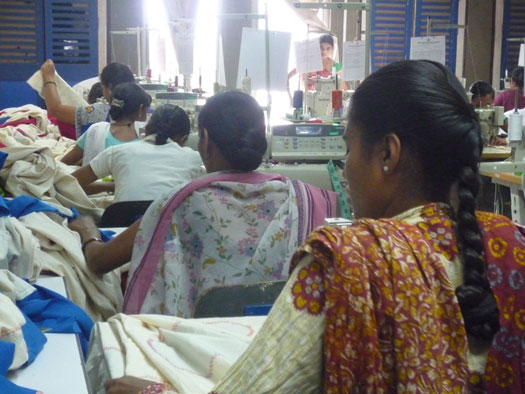
TFC Workers at their sewing machines

A woman demonstrates stencilling: first, a thin plastic-coated sheet is laid over a piece of fabric; second, she places tiny pinprick-sized dots in the plastic to outline the pattern; and third, zinc powder is combined with water to create a dye that is fugitive, whereupon it is rubbed over the cloth. The rubbed residue creates a template on top of the fabric, which is then sent to the villages for embroidery: once it is washed, the dye disappears, leaving only the decorative stiching
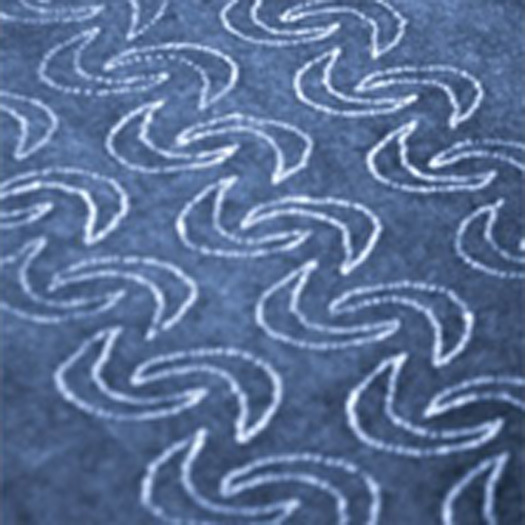
Detail of embroidery
Mona Shah and Christina Kim are but two of a small number of design emissaries working with the women of SEWA, but there are others: French sculptor Corinne Forget worked with women in the Kutch tribes, a drought-prone area near the Pakistan border where embroidery (there are said to be at least 16 different kinds) is a principal export. British designer Graham Hollick traveled a year ago to Radhanpur, on the edges of the Kutch desert, where he observed the kinds of skills and handiwork particular to this region. He spent two weeks working with SEWA members there as he developed methods for adapting their skills to his vision, and ultimately created a series of palettes representing not only color but also form, pattern and technique.
Put another way: Hollick reimagined what design could be based on, given the unique capabilities of these formally uneducated but remarkably gifted women. The point is to maximize the benefit for everyone: from better use of existing skills, to better access to the people with those skills, to better export of the best of what those skills can ultimately produce. If you consider design as a basic, nonverbal but intensely communicative process, you’ve got a sense of the degree to which design can function as an international language. Add to this the idea of an outside designer working with local artisans, and you’ve got an innovative model precisely because it’s not a top-down power play: on the contrary, the relationship with the incoming designer — and the process that follows — is managed carefully and respectfully. The big idea here lies in the notion of cross-cultural collaboration, cooperation and craft.
It turns out that while SEWA’s membership is enormous, it’s not alone in its efforts to promote the value of design through a socially progressive production model. Mumbai-based Krishna Mehta is another designer who employs artisans (in Mehta’s case, disabled ones) in her own printing and embroidery facility in Gujarat. Mehta’s work is at once spare and spectacular: contemporary in cut and line and profoundly classical in terms of fabric and detail. Her extraordinary clothes — available for both men and women — hang on two long racks in a small shop in Colaba, manned by her sister, who also does the tailoring.
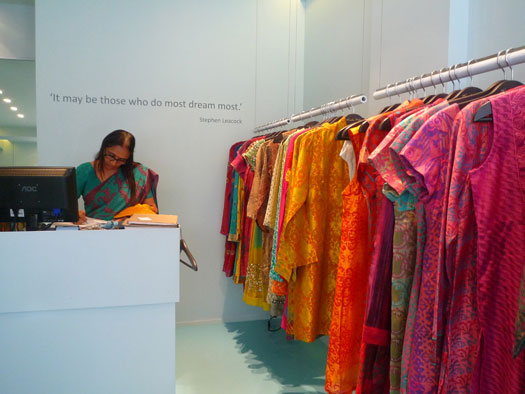
Jyoti Gokani, designer Krishna Mehta’s sister, in her shop in the Colaba district of Mumbai
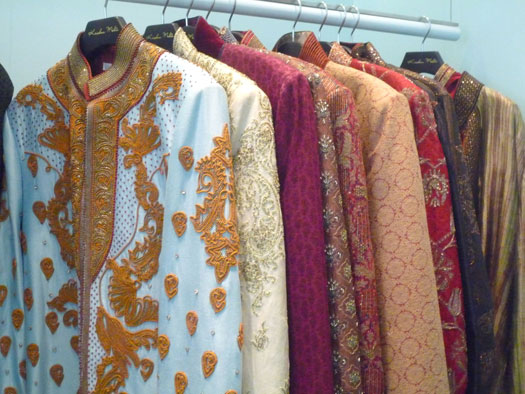
Examples of Mehta’s kurtas for men
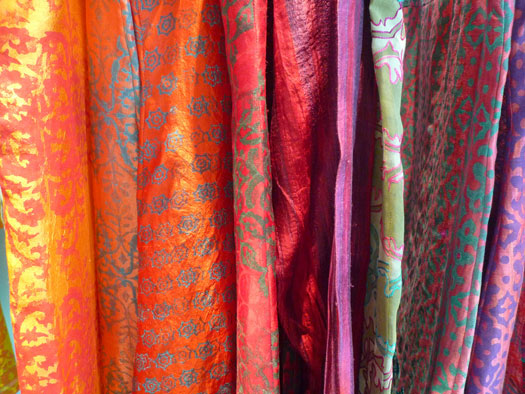
Examples of some of Mehta’s block-printed silks for women
Retail outlets like Mehta’s are enchanting, yet like most consumer-based showrooms, they don’t reveal the process in the product. SEWA’s Trade Facilitation Centre does. It’s an open atelier for incubating ideas: at present, the results are textile- and clothing-related, but there’s nothing to say that designers coming here can’t be product designers, type designers, graphic designers. If the point is to use design as an international language, then there’s no limit to the potential for exchange and education — which, in all honesty, goes both ways.
Observed
View all
Observed
By Jessica Helfand
Recent Posts
‘The conscience of this country’: How filmmakers are documenting resistance in the age of censorship Redesigning the Spice Trade: Talking Turmeric and Tariffs with Diaspora Co.’s Sana Javeri Kadri “Dear mother, I made us a seat”: a Mother’s Day tribute to the women of Iran A quieter place: Sound designer Eddie Gandelman on composing a future that allows us to hear ourselves think
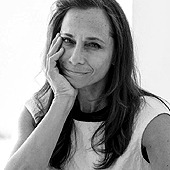 Jessica Helfand, a founding editor of Design Observer, is an award-winning graphic designer and writer and a former contributing editor and columnist for Print, Communications Arts and Eye magazines. A member of the Alliance Graphique Internationale and a recent laureate of the Art Director’s Hall of Fame, Helfand received her B.A. and her M.F.A. from Yale University where she has taught since 1994.
Jessica Helfand, a founding editor of Design Observer, is an award-winning graphic designer and writer and a former contributing editor and columnist for Print, Communications Arts and Eye magazines. A member of the Alliance Graphique Internationale and a recent laureate of the Art Director’s Hall of Fame, Helfand received her B.A. and her M.F.A. from Yale University where she has taught since 1994.


